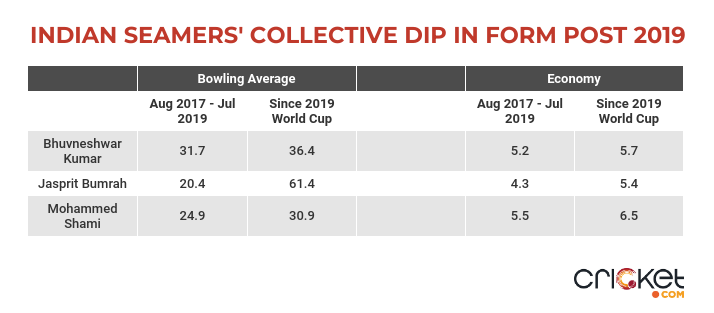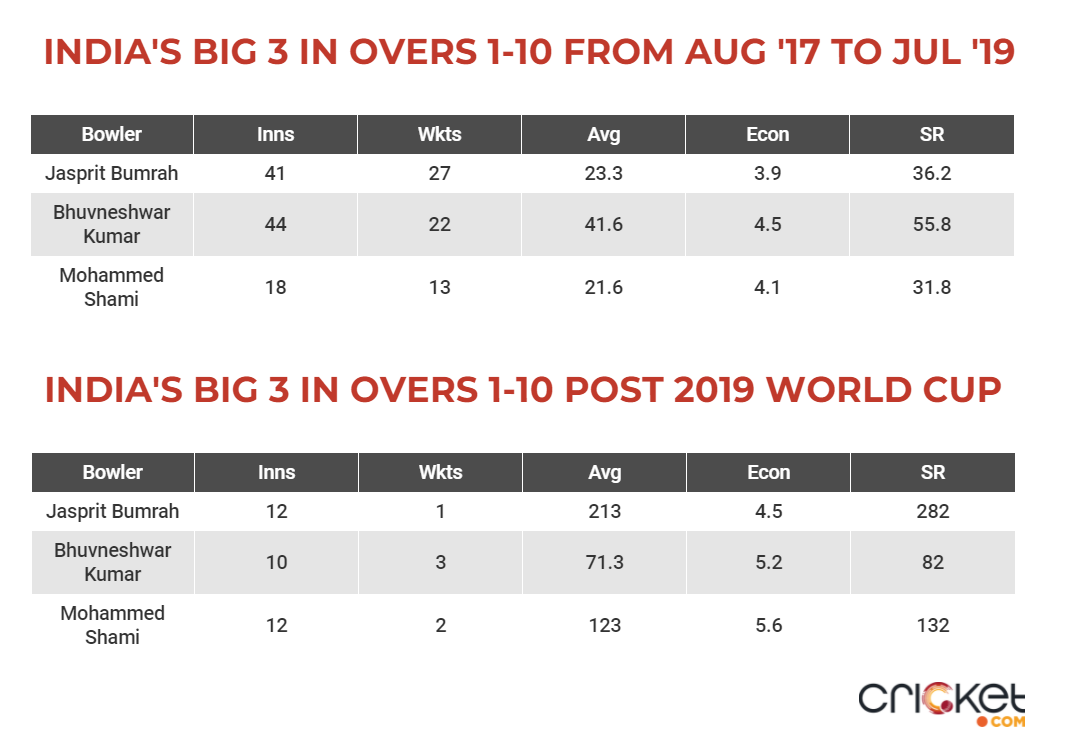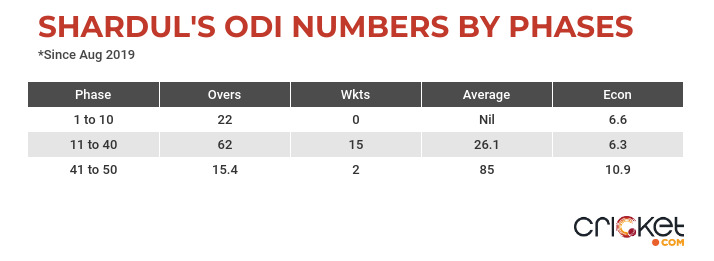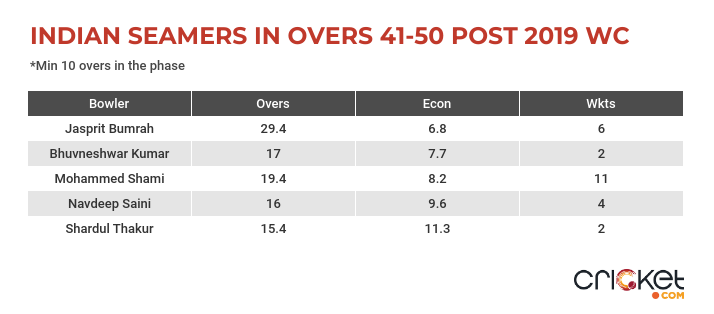News
What’s gone wrong with India’s pace bowling stocks in ODI cricket?
 DECODED
DECODEDAs the West Indies series beckons, in the firing line currently is India’s pace department, which has misfired big-time post the 2019 World Cup
The 2017-19 era in Indian ODI cricket, where the Men in Blue dominated teams and achieved everything minus winning the World Cup, is famously known as the ‘KulCha era’. But it was also a period in which they possessed arguably the most potent pace attack in the country’s history.
Between August 2017 and July 2019, the Indian seamers took a staggering 236 wickets at an average of 30.7. Their record, in this period, was bettered by only two other teams - New Zealand and South Africa - but the pace battery, led by Jasprit Bumrah, showed in the 2019 World Cup that they were as good as any attack in the world, finishing the competition with the best bowling average (24.1) and strike rate (28.4).
In its own right, the pace battery had every right to claim that it was as potent as the lethal Kul-Cha combo the world was in awe of.
Who would have thought then that, in the following two years, this very pace unit, with minimal personnel changes, would end up turning into the most impotent attack in the whole world, even more innocuous than the likes of Oman, UAE, USA, and PNG?
India have played 24 ODIs since the 2019 World Cup and, in this period, have comfortably been the worst pace bowling side in the world, averaging 41.8 while leaking runs at an ER of 6.3.
The situation is precisely as bad as the numbers suggest, evident by the thumpings at the hands of New Zealand, South Africa, and Australia.
We break down what has gone wrong in this period, and look at what the management should do in the next 18 months in order to get the pace battery back on track.
What has gone wrong?
The collective slump in form of Bumrah, Bhuvneshwar and Shami
Since the 2019 World Cup, Indian pacers have the worst average and economy in the powerplay (overs 1-10), while they have been the most expensive side in the middle-overs (11-40). The major contributor to this has been the collective slump in form of their three frontline pacers - Bumrah, Bhuvneshwar, and Mohammed Shami.

The overall numbers above look bad enough. But a comparison of how the three bowlers have fared with the new ball, pre and post World Cup, pretty much tells the whole story.

Wickets with the new ball have completely dried up and this has, in turn, caused a domino effect.
Exiting the powerplay unscathed (or with minimal damage) has emboldened batting line-ups to bat at a brisk pace all innings, due to not only having set batters at their disposal, but also the security of wickets in hand. Throw in flat batting wickets and a spin unit that is also struggling, it is impossible to avoid punishment.
The Shardul Thakur experiment that has hurt the team
Since the 2019 World Cup, only Mohammed Shami and Jasprit Bumrah have bowled more overs in ODIs for India than Shardul Thakur. The abject showing of the right-arm seamer during this period, barring an odd game or two, has significantly added to the team’s woes in the pace department.
Thakur, in the past two-and-a-half years, has averaged 41.58 with the ball and has conceded runs at an eye-watering economy rate of 7.09. No seamer that has bowled more than 50 overs during this period has conceded at a higher rate.

While Thakur has managed to chip-in with wickets in middle-overs, the occasional good work he’s done has been constantly undone and overshadowed by the inconsistent, loose nature of his bowling.

Such hot-and-cold bowlers can be accommodated in sides where the frontline bowlers are firing, but with all of Bumrah, Bhuvneshwar and Shami enduring extended lean patches, Thakur’s unreliability and inconsistency has compounded problems in the pace department.
Lack of continuity in the format
Despite India having played 24 ODIs post the 2019 World Cup, no pacer in the team has played more than 12 matches during this period. Prioritization of Tests and T20Is (and understandably so, with the immediate focus being on WTC and T20WC) has resulted in lack of continuity for players in the 50-over format, something that could very well have contributed to the overall rustiness.
The team selection and scheduling in the last two years has been such that Bumrah and Shami have played together just 6 ODIs in the past 30 months. There is no question that India’s nosedive in pace numbers required deep introspection, but the problem has also been exacerbated by external factors.
What should be the team’s goals moving forward
Identify competent new-ball bowlers that can hurt teams up-front
The single most important issue that needs immediate attention is new ball bowling. Therefore, zeroing-in on reliable new-ball bowlers should be at the top of the team’s priority list.
Deepak Chahar, who played in the third ODI in Cape Town, is the first candidate that comes to mind but no less potent are Mohammed Siraj and Avesh Khan. With the selectors seemingly ready to move on from Bhuvneshwar (at least for the time being, evident by their move to drop him for the West Indies ODIs), it is time to give extended runs in the side to all three seamers.
While Chahar is your conventional swing-bowler that can run through teams in favorable conditions, both Siraj and Avesh are more dynamic and have the pace and skill to hurt batting line-ups even on the flattest of decks.
As a left-field choice, a player that could be worth keeping in the loop is Arshdeep Singh. With the prospect of T Natarajan returning to ODI cricket anytime soon looking highly unlikely, Arshdeep becomes an attractive choice to groom, given he is a left-armer. The 22-year-old, as he’s shown in the IPL, is adept bowling with the new ball but crucially is not merely reliant on swing and can hurt teams through multiple weapons.
It goes without saying that Bumrah and Shami will eventually pick up form with the new ball. But strength in depth is key to success and with powerplay bowling being the main area of concern, the management needs to spend a good chunk of the next six months identifying the right player(s).
Find a way to get rid of the unhealthy over-reliance on Bumrah at the death
As poor as Bumrah has been with the new ball since the 2019 World Cup, he has still been exceptional at the death. Bumrah has bowled 10 more overs than any other Indian seamer at the death in the last 2 years and has still managed to maintain the best economy, an astounding ER of 6.8.
The challenge for the management now is to find a way to decrease the over-reliance on Bumrah at the death by grooming and identifying someone adept and reliable bowling at the back end.
Outside of Bumrah, the last two years have been a struggle for Indian bowlers at the death in ODI cricket, with Bhuvneshwar being the only other bowler with acceptable numbers.

But now with Bhuvneshwar himself struggling of late, there lies an objective to identify a new face that the team can rely on in the final phase of the game.
The balance of the side might not allow the luxury to field a ‘death specialist’, therefore ample opportunities might need to be given to those already in the mix - Chahar, Siraj, Avesh and even Shami - to see who is the best fit. This conversation should also include Prasidh Krishna, who has so far done a fine job of being an enforcer in the middle-overs. Though his record as a death bowler in the IPL is underwhelming, Prasidh has all the attributes to be a successful commodity at the back end of ODI games.
Ensure continuity by fielding the strongest XI in lead-up to the World Cup
The main objective for the management should be to identify the right players, but it will be equally important to finalize the strongest XI (in this case, the first-choice seamers) and ensure to give the first-choice players a long run heading into the World Cup.
Role clarity, at the end of the day, is key to the success of both the individual and the team, and that can only be attained through continuity.
Hence while there might be the temptation to ‘rest’ key bowlers ahead of the mega event and keep them fresh, the team might actually benefit from the first-choice players, especially the bowlers, playing a handful of matches with each other so that they’re in sync with one another, crystal clear about their role in the side.
Therefore, immediately after the T20 World Cup in Australia, it might be time for the management to start prioritizing ODI cricket.